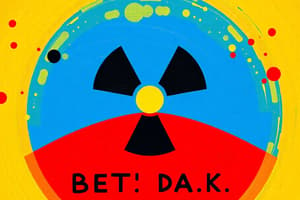Podcast
Questions and Answers
What is the formula to calculate nuclear binding energy?
What is the formula to calculate nuclear binding energy?
- E = mc^2 / Δm
- E = Δmc^2 (correct)
- E = mc / Δm
- E = Δm x c
In the context of nuclear binding energy, what does Δm represent?
In the context of nuclear binding energy, what does Δm represent?
- Mass of the nucleus
- Difference between the mass of the nucleus and total mass of nucleons (correct)
- Total mass of nucleons
- Velocity of light
What is the relationship between nuclear binding energy and the mass defect?
What is the relationship between nuclear binding energy and the mass defect?
- Exponential relationship
- Inversely proportional
- No relationship
- Directly proportional (correct)
What is the unit for nuclear binding energy typically expressed in?
What is the unit for nuclear binding energy typically expressed in?
What is the binding energy in Mega-electron Volts (MeV) for a nuclear binding energy of 10.0 eV?
What is the binding energy in Mega-electron Volts (MeV) for a nuclear binding energy of 10.0 eV?
In the context of nuclear binding energies, what does 'amu' stand for?
In the context of nuclear binding energies, what does 'amu' stand for?
What is the velocity of light used in the formula for nuclear binding energy calculation?
What is the velocity of light used in the formula for nuclear binding energy calculation?
'Mass defect' in the context of nuclear physics refers to:
'Mass defect' in the context of nuclear physics refers to:
'Binding energy' can be defined as:
'Binding energy' can be defined as:
'Nuclear binding energies' are typically expressed in which units?
'Nuclear binding energies' are typically expressed in which units?
Flashcards are hidden until you start studying
Study Notes
Introduction to Nuclear Chemistry
- Studying nuclear chemistry is crucial due to its applications in understanding stellar phenomena, medical treatments using radioactive isotopes, and the potential of nuclear power for future energy needs.
Contents Overview
- Topics covered include the nature of radioactivity, radioelements, isotopes, radionuclides, nuclear decay, nuclear radiation, and their applications in various fields including life sciences and environmental studies.
Historical Background
- Nuclear chemistry was advanced by Henri Becquerel's discovery of uranium's radiation emission in 1896.
- Marie Curie's work laid the foundation for understanding radioactivity, discovering that radiation intensity correlates with the amount of radioactive material.
Nuclear vs Chemical Reactions
- Chemical Reactions: Involve interactions of valence electrons outside the nucleus, small energy changes, and produce new matter without changing atom identities.
- Nuclear Reactions: Occur within the nucleus, involve changes in nuclear composition, lead to significant energy changes, and can convert one element into another.
Atomic Nucleus Basics
- The atomic nucleus consists of protons (positive charge) and neutrons (neutral), collectively known as nucleons.
- Each nucleus is identified by mass number (A) and atomic number (Z), with isotopes having the same proton number but different neutron counts.
Radioactivity and Stability
- Radioactivity is the spontaneous decay of unstable nuclei, emitting subatomic particles and radiation.
- The decay rate is specific to each radioisotope and measured in terms of half-life (t1/2), indicating the time for half of the radioactive nuclei to decay.
Nuclear Stability
- Stable atomic nuclei maintain balance against electrostatic repulsion between protons through a strong nuclear force.
- If the nuclear attractive forces are insufficient, the nucleus becomes unstable and undergoes decay.
Nucleus Components
- Particles:
- Electron (e-, β-): Charge -1, mass ~1.
- Positron (e+, β+): Charge +1, mass ~1.
- Proton (p): Charge +1, mass ~1836.1.
- Neutron (n): Charge 0, mass ~1838.6.
Nuclear Binding Energy
- The nuclear binding energy quantifies the energy needed to disassemble a nucleus into individual nucleons and represents the energy released when nucleons form a nucleus.
Mass Defect
- The mass defect refers to the difference in mass between a nucleus and the sum of its individual nucleons, highlighting the energy relationships within atomic structures.
Studying That Suits You
Use AI to generate personalized quizzes and flashcards to suit your learning preferences.




